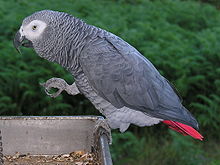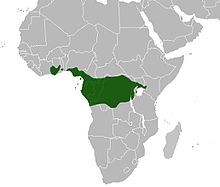African grey parrot
| African grey parrot | |
|---|---|
 |
|
| Scientific classification | |
| Kingdom: | Animalia |
| Phylum: | Chordata |
| Class: | Aves |
| Order: | Psittaciformes |
| Family: | Psittacidae |
| Genus: | Psittacus |
| Species: | P. erithacus |
| Binomial name | |
|
Psittacus erithacus Linnaeus, 1758 |
|
 |
|
| Range of the Congo grey parrot | |
The African grey parrot (Psittacus erithacus) is an Old World parrot in the family Psittacidae. This article describes the Congo African grey parrot. The Timneh parrot (Psittacus timneh) has been split into a distinct species.
The African grey parrot is a medium-sized, predominantly grey, black-billed parrot which weighs 400 g, with a length of 33 cm and an average wingspan of 46–52 cm. The Congo subspecies is a lighter grey, with darker grey over the head and both wings, while the head and body feathers have a slight white edge to them. The tail feathers are red. The Timneh subspecies is a darker gray and has a dark maroon colored tail as well as having a portion of their beak being light pink in color. Due to artificial selection by parrot breeders, some Congo African grey parrots are partially or completely red. Both sexes appear similar. The coloration of juveniles is similar to that of adults, but the eye is typically dark grey to black, in comparison to the yellow irises around dark eyes of the adult birds. The undertail coverts are also tinged with grey. The adults weigh between 418 and 526 grams.
African grey parrots may live for 40–60 years in captivity, although their mean lifespan in the wild appears to be shorter at about 23 years.
The African grey parrot is native to equatorial Africa, including Angola, Cameroon, Congo, Côte d'Ivoire, Ghana, Kenya, and Uganda. The species is found inside a range from Kenya to the eastern part of the Ivory Coast. Between 120,100 and 259,000 Timneh African gray parrots remain worldwide. Current estimates for the global population of Congo African grey parrots are uncertain and range from 0.63 to 13 million birds. Populations are decreasing worldwide. The species seems to favor dense forests, but can also be found at forest edges and in more open vegetation types (gallery and savanna forests).
A population study published in 2015 found that the species had been ″virtually eliminated″ from Ghana with numbers declining 90 to 99% since 1992. They were found in only 10 of 42 forested areas, and in three roosts that once held between 700 and 1200 birds each, now had only 18 in total. Local people mainly blamed the pet trade, and the felling of timber for the decline. Populations are thought to be stable in Cameroon, and in the Congo an estimated 15,000 are taken every year for the pet trade, from the eastern part of the country. The annual quota is 5,000.
...
Wikipedia

